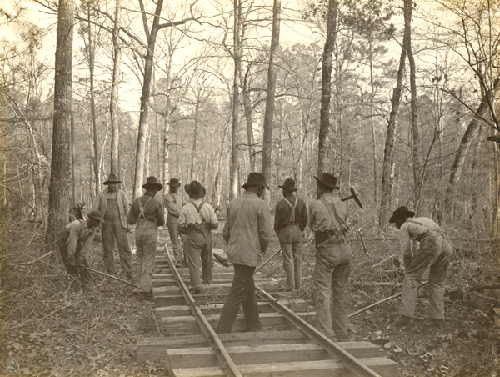
04 - Piney Woods of East Texas
by John Tennison — History of Boogie Woogie

Photo Above: Steel Gang Laying a Logging Railroad in the Piney Woods of East Texas. The image is from the East Texas Research Center Collection.
"Although the neighboring states of Arkansas, Louisiana, and Missouri would also produce boogie-woogie players and their boogie-woogie tunes, and despite the fact that Chicago would become known as the center for this music through such pianists as Jimmy Yancey, Albert Ammons, and Meade Lux Lewis, Texas was home to an environment that fostered creation of boogie-style: the lumber, cattle, turpentine, and oil industries, all served by an expanding railway system from the northern corner of East Texas to the Gulf Coast and from the Louisiana border to Dallas and West Texas." (page 75)13
—Dave Oliphant
Although there is an obvious typographical error in his comments, in "Looking Up at Down: The Emergence of Blues Culture,"76William Barlow writes in Chapter 7, page 231:
"Piano players were the first blues musicians associated with the Deep Ellum tenderloin. In Dallas, Houston, and other cities of Eastern Texas, the prevailing piano style of uptempo blues numbers was called "Fast Western" or "Fast Texas." An offshoot of boogie woogie, it probably came from the "Piney Woods" lumber and turpentine camps based in northwest Texas, northern Louisiana, and southern Arkansas. However, the style became a fixture in "Deep Ellum" after the turn of the century."
Barlow obviously meant to write "northeast Texas," as there were no "Piney Woods" or "turpentine camps" in "northwest Texas." This typo is also obvious in that it is"northeast Texas" that is at the confluence of "northern Louisiana" and "southern Arkansas", an area currently known as the Arklatex. These comments on the origin of Boogie Woogie by Barlow are consistent with the 1899 witnessing by Leadbelly, as well as with the account given by Lee Ree Sullivan of Texarkana.
Moreover, since piano players were the "first blues musicians" in Deep Ellum, Barlow’s comments suggest that Blind Lemon Jefferson might have borrowed his "Booga Rooga" guitar bass figure from Boogie Woogie pianists in Deep Ellum, but given travels with Lead Belly on the T&P line, Jefferson could have also heard such Boogie Woogie pianists at other locations in Texas. Jefferson might have also derived his "Booga Rooga" bass line from Lead Belly, after Leadbelly witnessed Boogie Woogie bass lines played by pianists in the Arklatex.







